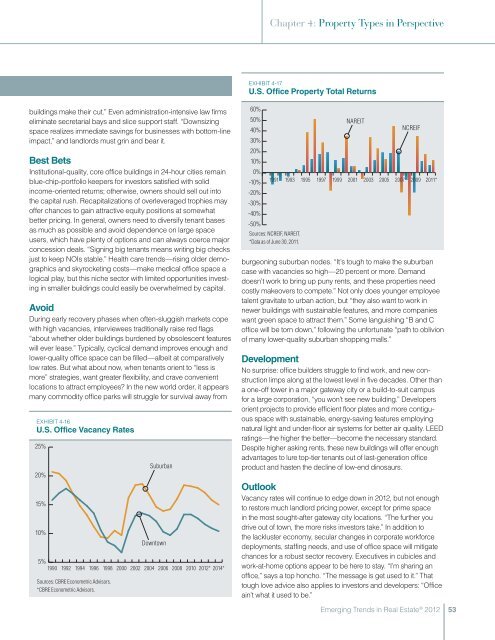Emerging Trends in Real Estate 2012 - Urban Land Institute
Emerging Trends in Real Estate 2012 - Urban Land Institute
Emerging Trends in Real Estate 2012 - Urban Land Institute
You also want an ePaper? Increase the reach of your titles
YUMPU automatically turns print PDFs into web optimized ePapers that Google loves.
Chapter 4: Property Types <strong>in</strong> Perspective<br />
Exhibit 4-17<br />
U.S. Office Property Total Returns<br />
build<strong>in</strong>gs make their cut.” Even adm<strong>in</strong>istration-<strong>in</strong>tensive law firms<br />
elim<strong>in</strong>ate secretarial bays and slice support staff. “Downsiz<strong>in</strong>g<br />
space realizes immediate sav<strong>in</strong>gs for bus<strong>in</strong>esses with bottom-l<strong>in</strong>e<br />
impact,” and landlords must gr<strong>in</strong> and bear it.<br />
Best Bets<br />
Institutional-quality, core office build<strong>in</strong>gs <strong>in</strong> 24-hour cities rema<strong>in</strong><br />
blue-chip-portfolio keepers for <strong>in</strong>vestors satisfied with solid<br />
<strong>in</strong>come-oriented returns; otherwise, owners should sell out <strong>in</strong>to<br />
the capital rush. Recapitalizations of overleveraged trophies may<br />
offer chances to ga<strong>in</strong> attractive equity positions at somewhat<br />
better pric<strong>in</strong>g. In general, owners need to diversify tenant bases<br />
as much as possible and avoid dependence on large space<br />
users, which have plenty of options and can always coerce major<br />
concession deals. “Sign<strong>in</strong>g big tenants means writ<strong>in</strong>g big checks<br />
just to keep NOIs stable.” Health care trends—ris<strong>in</strong>g older demographics<br />
and skyrocket<strong>in</strong>g costs—make medical office space a<br />
logical play, but this niche sector with limited opportunities <strong>in</strong>vest<strong>in</strong>g<br />
<strong>in</strong> smaller build<strong>in</strong>gs could easily be overwhelmed by capital.<br />
Avoid<br />
Dur<strong>in</strong>g early recovery phases when often-sluggish markets cope<br />
with high vacancies, <strong>in</strong>terviewees traditionally raise red flags<br />
“about whether older build<strong>in</strong>gs burdened by obsolescent features<br />
will ever lease.” Typically, cyclical demand improves enough and<br />
lower-quality office space can be filled—albeit at comparatively<br />
low rates. But what about now, when tenants orient to “less is<br />
more” strategies, want greater flexibility, and crave convenient<br />
locations to attract employees In the new world order, it appears<br />
many commodity office parks will struggle for survival away from<br />
Exhibit 4-16<br />
U.S. Office Vacancy Rates<br />
25%<br />
20%<br />
15%<br />
10%<br />
5%<br />
1990 1992<br />
Sources: CBRE Econometric Advisors.<br />
*CBRE Econometric Advisors.<br />
Suburban<br />
Downtown<br />
1994 1996 1998 2000 2002 2004 2006 2008 2010 <strong>2012</strong>* 2014*<br />
60%<br />
50%<br />
40%<br />
30%<br />
20%<br />
10%<br />
0%<br />
-10%<br />
-20%<br />
-30%<br />
-40%<br />
-50%<br />
1991<br />
1993<br />
Sources: NCREIF, NAREIT.<br />
*Data as of June 30, 2011.<br />
1995<br />
1997<br />
1999<br />
NAREIT<br />
NCREIF<br />
2011*<br />
burgeon<strong>in</strong>g suburban nodes. “It’s tough to make the suburban<br />
case with vacancies so high—20 percent or more. Demand<br />
doesn’t work to br<strong>in</strong>g up puny rents, and these properties need<br />
costly makeovers to compete.” Not only does younger employee<br />
talent gravitate to urban action, but “they also want to work <strong>in</strong><br />
newer build<strong>in</strong>gs with susta<strong>in</strong>able features, and more companies<br />
want green space to attract them.” Some languish<strong>in</strong>g “B and C<br />
office will be torn down,” follow<strong>in</strong>g the unfortunate “path to oblivion<br />
of many lower-quality suburban shopp<strong>in</strong>g malls.”<br />
Development<br />
No surprise: office builders struggle to f<strong>in</strong>d work, and new construction<br />
limps along at the lowest level <strong>in</strong> five decades. Other than<br />
a one-off tower <strong>in</strong> a major gateway city or a build-to-suit campus<br />
for a large corporation, “you won’t see new build<strong>in</strong>g.” Developers<br />
orient projects to provide efficient floor plates and more contiguous<br />
space with susta<strong>in</strong>able, energy-sav<strong>in</strong>g features employ<strong>in</strong>g<br />
natural light and under-floor air systems for better air quality. LEED<br />
rat<strong>in</strong>gs—the higher the better—become the necessary standard.<br />
Despite higher ask<strong>in</strong>g rents, these new build<strong>in</strong>gs will offer enough<br />
advantages to lure top-tier tenants out of last-generation office<br />
product and hasten the decl<strong>in</strong>e of low-end d<strong>in</strong>osaurs.<br />
Outlook<br />
Vacancy rates will cont<strong>in</strong>ue to edge down <strong>in</strong> <strong>2012</strong>, but not enough<br />
to restore much landlord pric<strong>in</strong>g power, except for prime space<br />
<strong>in</strong> the most sought-after gateway city locations. “The further you<br />
drive out of town, the more risks <strong>in</strong>vestors take.” In addition to<br />
the lackluster economy, secular changes <strong>in</strong> corporate workforce<br />
deployments, staff<strong>in</strong>g needs, and use of office space will mitigate<br />
chances for a robust sector recovery. Executives <strong>in</strong> cubicles and<br />
work-at-home options appear to be here to stay. “I’m shar<strong>in</strong>g an<br />
office,” says a top honcho. “The message is get used to it.” That<br />
tough love advice also applies to <strong>in</strong>vestors and developers: “Office<br />
a<strong>in</strong>’t what it used to be.”<br />
2001<br />
2003<br />
2005<br />
2007<br />
2009<br />
<strong>Emerg<strong>in</strong>g</strong> <strong>Trends</strong> <strong>in</strong> <strong>Real</strong> <strong>Estate</strong> ® <strong>2012</strong><br />
53




